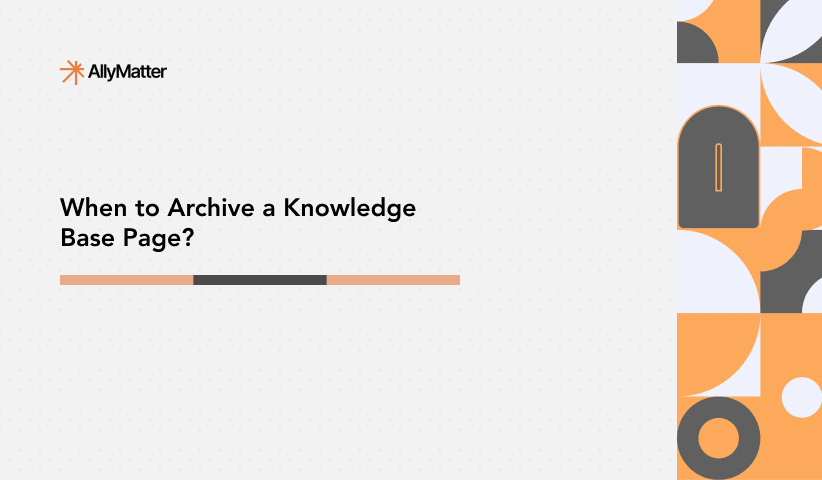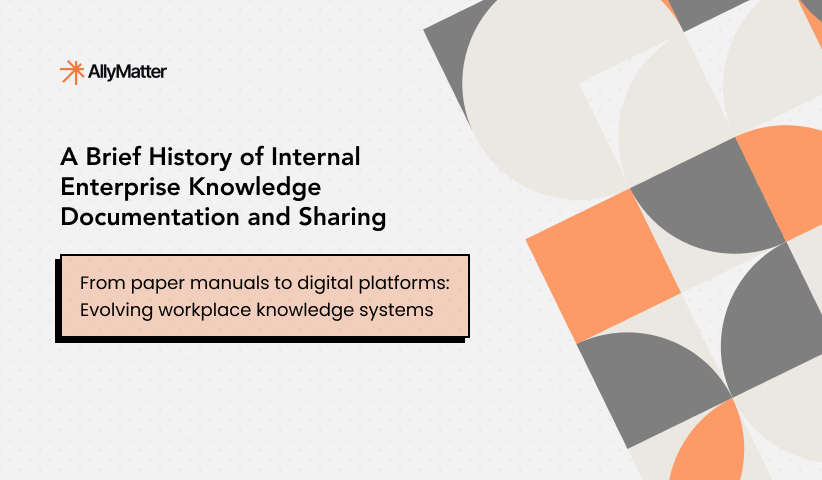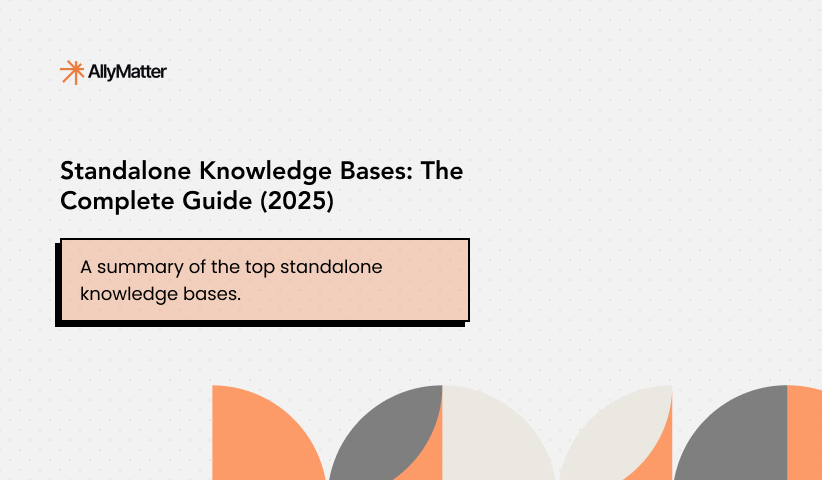Most knowledge bases operate on a fundamentally reactive model; a gap is identified, content is created, and then users (hopefully) find that information when they need it. This approach means customers and employees inevitably experience periods where crucial information is missing, incomplete, or difficult to find.
The cost of this reactive cycle is substantial but often hidden, measured in wasted time, unnecessary support interactions, customer frustration, and employee inefficiency.
According to McKinsey research, employees spend nearly 20% of their workweek looking for internal information or tracking down colleagues for help. Meanwhile, Panopto research reveals that U.S. knowledge workers waste 5.3 hours every week either waiting for vital information from colleagues or working to recreate existing institutional knowledge.
Organizations that break this cycle by implementing predictive knowledge base analytics gain a significant competitive advantage, addressing information needs before they become problems.
This shift from reactive to proactive documentation isn’t just a technical evolution. It represents a fundamental change in how organizations think about knowledge management. Rather than treating documentation as a response to known issues, forward-thinking companies use analytics to anticipate and address information needs before they surface as support tickets or frustrated searches.
Understanding predictive knowledge base analytics
Predictive knowledge analytics uses historical usage data, content performance patterns, and contextual signals to identify emerging information needs before they become widespread. Unlike traditional documentation metrics that measure past performance, predictive analytics focuses on identifying future content requirements.
This approach combines several data streams:
- Search analytics revealing what users are looking for
- Content engagement patterns showing how information is consumed
- User context data indicating when and why people seek information
- Product usage telemetry correlating feature usage with documentation needs
- External signals like seasonality, market changes, or industry events
By analyzing these patterns collectively rather than in isolation, organizations can identify leading indicators of information needs, the early signals that precede widespread demand for specific content.
Key predictive indicators in knowledge base data
Specific patterns within your knowledge base data serve as reliable predictors of emerging information needs:
Search pattern analysis
The most direct predictors often come from search behavior. Look for:
Emerging search terms that appear with increasing frequency but yield poor results. These represent new terminology, concepts, or requirements entering your users’ vocabulary before your documentation has caught up. A sudden increase in searches for unfamiliar terms often precedes a wave of support tickets by 1-2 weeks.
Search refinement sequences where users modify their initial queries multiple times, indicating they’re struggling to find information using your current terminology. When multiple users follow similar refinement patterns, it signals a terminology gap between how you describe features and how users think about them.
Contextual search timing relates searches to user journeys or external events. For example, an increase in security-related searches immediately following industry compliance changes indicates an information need triggered by external factors.
Content consumption sequences
How users navigate through your knowledge base reveals predictable information-seeking patterns:
Sequential content consumption shows natural learning progressions. When users consistently follow specific article sequences, you can predict what information they’ll need next based on what they’ve already viewed. These patterns allow you to proactively recommend the next most helpful resource.
Abandonment points in common content sequences indicate where users’ information needs go unmet. These points of disruption predict future support tickets if not addressed.
Repeated reference patterns identify information that users need regularly but struggle to relocate. Content frequently accessed by the same users signals information that should be more prominently featured or personalized for those individuals.
Seasonal and cyclical information needs
Many information needs follow predictable cycles:
Annual business cycles drive documentation requirements for processes like budgeting, performance reviews, or tax preparations. Historical knowledge base usage during these periods predicts similar patterns in upcoming cycles.
Product lifecycle events like major releases, updates, or retirements create predictable documentation needs. By analyzing content consumption during previous releases, you can anticipate what information users will seek during upcoming changes.
Customer lifecycle stages from onboarding through renewal create predictable information needs. New customers typically seek similar information in similar sequences, allowing you to predict and proactively address their questions.
Product usage correlation with documentation needs
For software products, usage data provides powerful predictive signals:
Feature adoption patterns correlate with documentation needs. When users begin exploring new features, specific help-seeking behaviors typically follow. By monitoring feature usage, you can predict upcoming documentation requirements.
Error and exception events within the product often precede knowledge base searches. A spike in specific errors predicts increased demand for related troubleshooting content, sometimes before users actively search for solutions.
Usage intensity metrics like time spent in certain product areas correlate with documentation depth requirements. Features with high usage time but limited documentation views may indicate overly intuitive areas or critically underserved information needs.
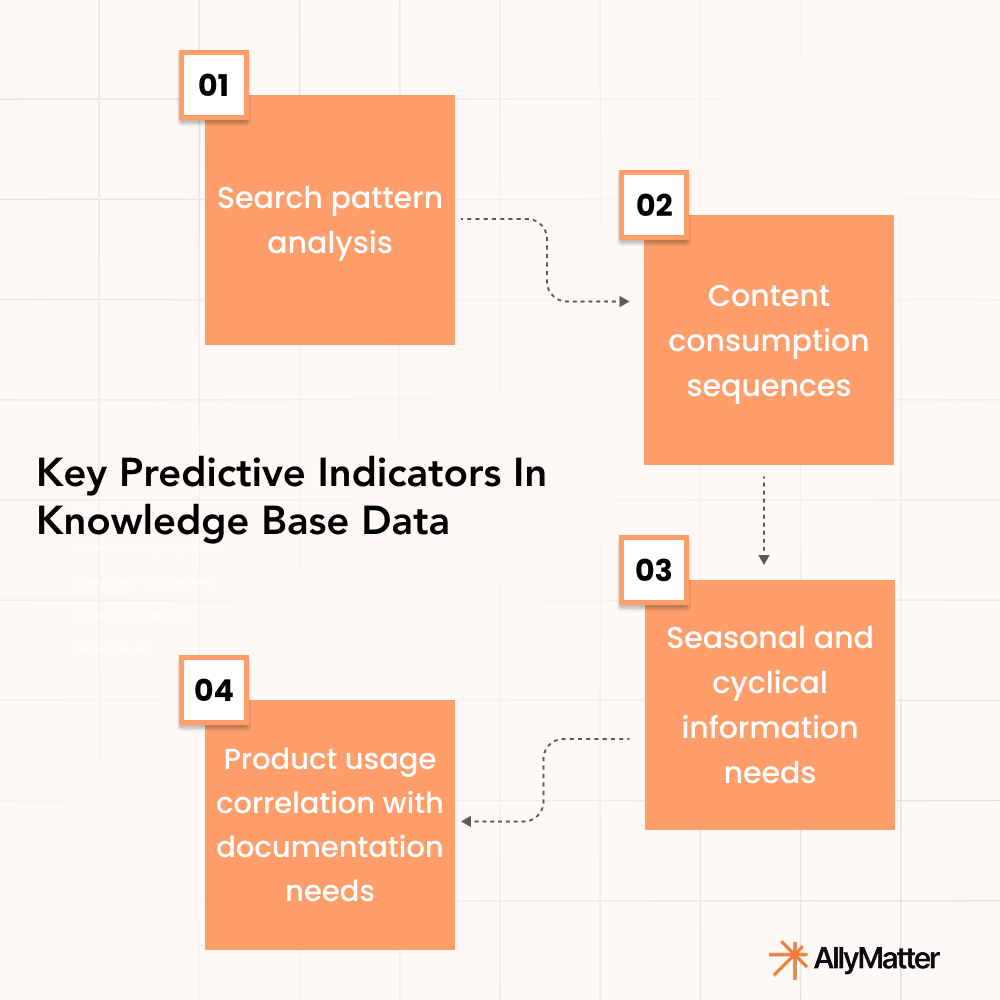
Implementing a predictive analytics framework
Building predictive capabilities requires systematic implementation:
Implement data collection mechanisms
Start by ensuring you capture the right data:
Unified search analytics should track not just search terms but also result quality, user actions after searching, and search refinements. Implement tracking that follows the entire search journey, not just initial queries.
Article performance metrics should include time on page, scroll depth, navigation patterns after viewing, and problem resolution rates. Simple view counts provide limited predictive value compared to engagement quality metrics.
User context markers connect knowledge seeking to specific user states: their role, experience level, location in the product, and stage in the customer journey. This contextual data transforms basic metrics into predictive signals.
Cross-platform tracking connects knowledge-seeking across channels, from documentation to community forums to support tickets. Users rarely restrict their information seeking to a single channel, and neither should your analytics.
Establishing baseline measurements
Before making predictions, establish reliable baselines:
Seasonal pattern baselines require at least one full annual cycle of data, preferably more, to accurately identify cyclical variations in information needs. Document these patterns as a foundation for predictions.
Content performance benchmarks should be segmented by content type, audience, and purpose. Technical troubleshooting content has different engagement patterns than conceptual educational materials.
Search success baselines help distinguish between normal search behavior and problematic patterns indicating information gaps. Define what “successful” search looks like for your specific knowledge base.
Integrating product telemetry with knowledge analytics
For maximum predictive power, connect product usage with documentation behavior:
Feature usage tracking should feed into your knowledge base analytics to correlate product actions with information needs. This connection is often the missing link in knowledge analytics programs.
Error monitoring integration allows you to anticipate documentation needs based on product challenges before users actively seek help. Set up alerts for error patterns that historically correlate with documentation searches.
User journey mapping should span both product usage and knowledge base interaction, creating a unified view of when and why users seek information during product experiences.
Creating feedback loops for continuous refinement
Predictive systems improve through structured feedback:
Prediction accuracy tracking measures how often your anticipated information needs materialize. Document both successful predictions and misses to refine your predictive models.
Content effectiveness validation confirms whether proactively created content actually addresses the anticipated need. Monitor engagement with predictive content compared to reactively created materials.
Support team integration provides human validation of predictive insights. Regular reviews with support staff help confirm whether predicted information needs match what they’re hearing from customers.
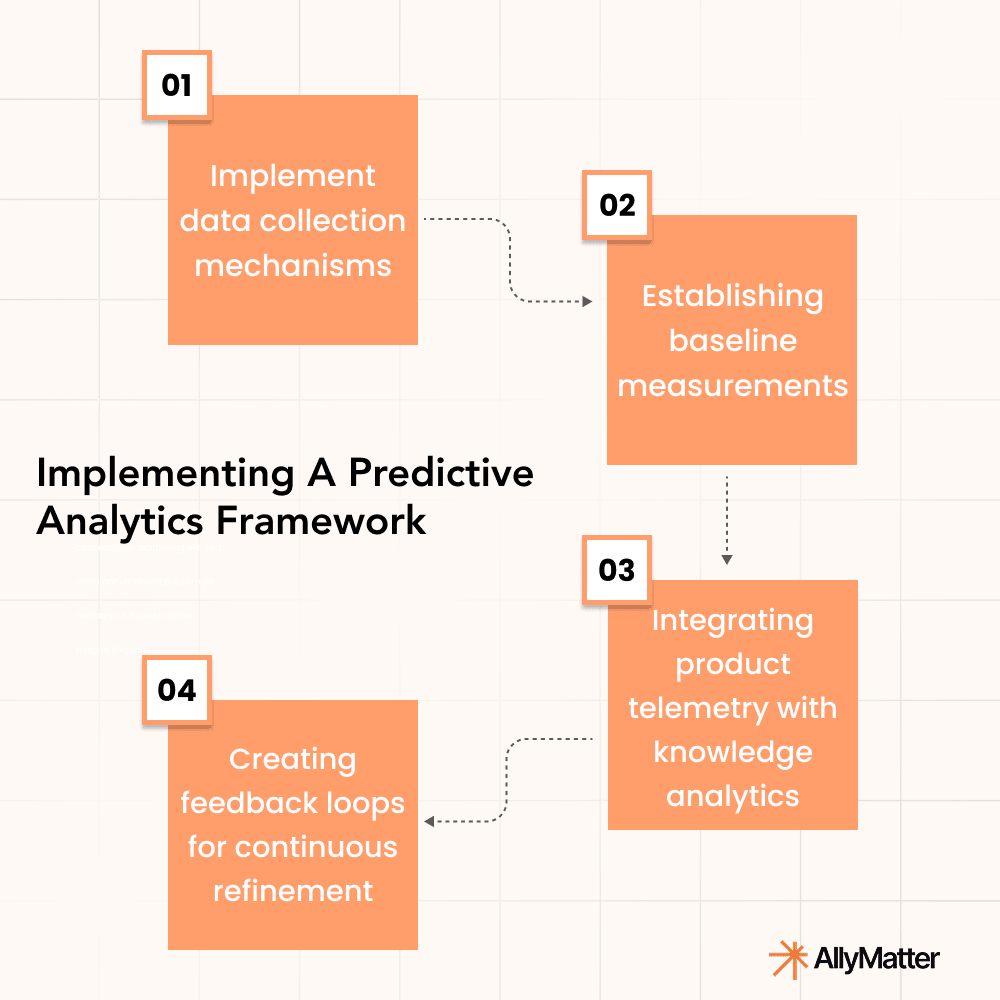
Practical applications of predictive knowledge analytics
Predictive insights drive specific actions that transform knowledge management:
Pre-emptive content creation
Use predictive signals to develop content before widespread need:
Seasonal content calendars based on historical patterns ensure you prepare documentation before predictable demand spikes. Develop and update tax-season support content in January, not April, for example.
Release-driven documentation developed based on predictive models ensures new feature documentation is ready before most users discover functionality, not weeks after.
Trending topic expansion monitors early search patterns to identify emerging information needs requiring expanded coverage. When a handful of users start searching for a new term, it often signals a coming wave of similar searches.
Timely resource allocation for documentation
Predictive analytics enables more efficient resource planning:
Documentation sprint planning informed by predicted information needs ensures writers focus on content that will soon be in demand. This approach replaces the common practice of prioritizing based on whoever is shouting the loudest.
Subject matter expert scheduling based on anticipated content needs helps secure time with busy experts before critical documentation deadlines. Predictive data provides compelling evidence when requesting expert contribution.
Translation and localization forecasting identifies content likely to need translation based on international usage patterns, allowing for more efficient localization workflows.
Personalized knowledge recommendations
Individual usage patterns enable tailored information delivery:
Role-based predictive recommendations anticipate different information needs based on user roles and responsibilities. An administrator likely needs different resources than an end-user, even when using the same feature.
Experience-level adaptation provides different content depth based on the user’s expertise level, predicted from their previous knowledge base interactions. New users receive more foundational content, while power users get advanced materials.
Journey-stage recommendations deliver different resources based on where users are in their lifecycle, from implementation to mature usage, even when looking at the same topics.
Product development insights from information seeking
Predictive knowledge analytics influences product decisions:
Feature friction identification pinpoints product areas generating consistent documentation needs, often indicating usability issues that could be addressed through design improvements.
Terminology alignment opportunities emerge when search patterns consistently use a different language than your interface and documentation. These patterns suggest where product language should be reconsidered.
Feature prioritization insights come from monitoring which undocumented or minimally documented areas generate the most searches, indicating unexpected user interest that product teams should explore.
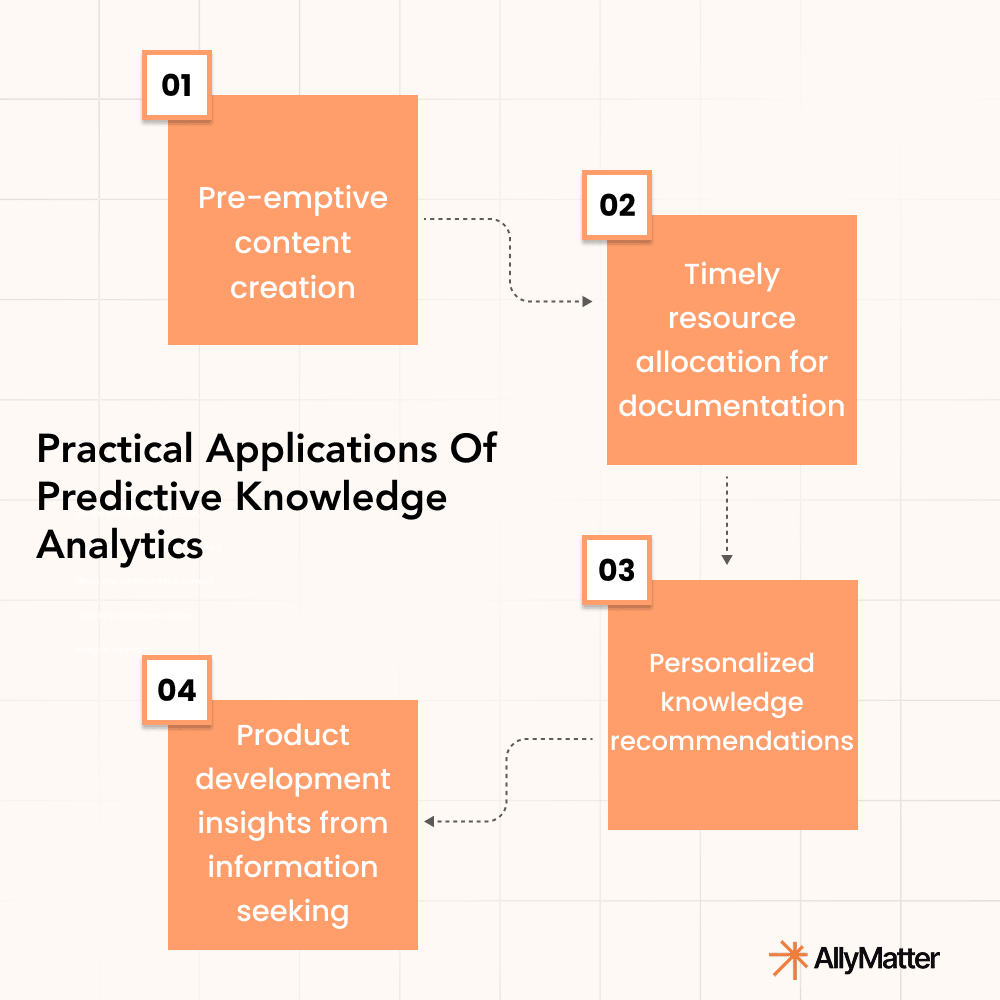
Challenges in predictive documentation
Implementing predictive knowledge approaches presents several challenges:
Data privacy and ethical considerations
As with any advanced analytics, privacy concerns must be addressed:
Anonymization requirements mean you need sufficient aggregated data to identify patterns without tracking individuals. Implement appropriate anonymization techniques while still preserving contextual signals.
Consent and transparency around how you use knowledge base analytics should be clearly communicated to users. Make your privacy policies explicit about how usage data informs content development.
Data retention policies should balance analytical needs with privacy best practices. Consider whether you need long-term individual-level data or if aggregated trend data serves your predictive needs.
Avoiding false pattern recognition
Not all patterns represent meaningful signals:
Statistical significance thresholds help distinguish between random variation and true predictive patterns. Establish minimum sample sizes and confidence levels before acting on apparent trends.
Correlation vs. causation analysis ensures you don’t mistake coincidental patterns for predictive relationships. Test hypothesized relationships through controlled experiments when possible.
Outlier management prevents unusual cases from skewing predictions. Implement systems to identify and appropriately weight anomalous usage patterns.
Balancing automation with human expertise
While analytics provide powerful insights, human judgment remains essential:
Subject matter expert validation should confirm that analytically identified needs align with domain expertise. Create review processes where experts assess predicted information needs.
Quality vs. speed tradeoffs arise when rapidly creating content to meet predicted needs. Establish minimum quality standards even for fast-response content.
Context awareness limitations of automated systems require human oversight. Some information needs are driven by nuanced factors that analytics may miss, requiring human interpretation of raw data.
Scaling predictive systems effectively
As your knowledge base grows, predictive capabilities must scale accordingly:
Data volume management becomes increasingly complex with larger knowledge bases and user populations. Implement appropriate data storage and processing architectures.
Multi-audience complexity increases as you serve diverse user segments with different needs. Develop segmented predictive models rather than one-size-fits-all approaches.
Cross-language prediction adds complexity for international organizations. Begin with primary language analysis before expanding predictive capabilities across language versions.
Measuring success
Evaluate your predictive knowledge program through specific metrics:
Indicators of predictive effectiveness
Track how well your system anticipates actual needs:
Prediction accuracy rate measures how often predicted information needs to materialize. Track the percentage of proactively created content that subsequently receives significant usage.
Time advantage metrics quantify how far in advance your predictions identify needs before widespread demand emerges. The goal is increasing this lead time to allow for better content preparation.
Gap reduction measurements track how predictive approaches reduce the total number of information gaps experienced by users. Monitor metrics like zero-search results and support ticket topics without corresponding documentation.
Evaluating ROI of proactive documentation
Quantify the business impact of your predictive approach:
Support deflection differential compares ticket volumes before and after implementing predictive documentation. Proactive content typically shows higher deflection rates than reactively created materials.
Content efficiency metrics measure resource utilization; predictive approaches often require less total content creation by addressing root needs rather than symptoms. Track total content volume relative to information coverage.
Time-to-value acceleration measures how predictive documentation speeds up user success. Compare time-to-proficiency for users with access to proactive content versus those with only reactive resources.
Quantifying customer impact
Ultimately, success is measured through user outcomes:
Frustration reduction metrics like reduced search refinements, fewer support escalations, and decreased abandonment rates indicate more effective information delivery.
User satisfaction differentials between areas with predictive documentation and those without reveal impact on experience. Use targeted surveys to assess these differences.
Feature adoption acceleration often results from better predictive documentation. Compare adoption rates for features with proactive versus reactive documentation approaches.
How AllyMatter enables predictive knowledge management
AllyMatter provides the analytics foundation needed for predictive content strategies without requiring enterprise-level resources. Our platform captures detailed search analytics, user behavior patterns, and content performance metrics that reveal emerging information needs.
With smart tagging systems for both documents and users, comprehensive audit trails, and granular access analytics, you can identify which content gaps are developing before they impact productivity. Our structured approval workflows and commentary features capture valuable feedback that informs future content development, helping your team anticipate and address information needs proactively.
The future of knowledge management
The evolution toward predictive documentation continues to accelerate:
From prediction to prescription
The next frontier moves beyond predicting information needs to prescribing specific content strategies:
Automated content creation will increasingly generate first drafts of predicted content needs, with human experts editing and enhancing rather than creating from scratch.
Dynamic content personalization will tailor information presentation based on predicted individual needs rather than generic user segments.
Continuous quality optimization will automatically refine content based on predicted effectiveness rather than waiting for performance data.
The evolving role of documentation professionals
Documentation teams will transition from primarily creating content to orchestrating knowledge systems:
Knowledge strategists will focus on designing information architectures that adapt to predicted needs rather than building static structures.
Analytics interpreters will become crucial for translating data signals into content strategy, combining technical analysis with content expertise.
Cross-functional collaboration facilitators will coordinate between product, support, and documentation teams based on predictive insights.
Building a culture of anticipatory support
Organizations that thrive will develop an anticipatory mindset:
Proactive resource allocation will become normal, with documentation resources assigned based on predicted needs rather than current backlogs.
Metric-driven documentation prioritization will replace subjective assessments of content importance.
Knowledge-centered product development will incorporate documentation requirements earlier in the development cycle based on predicted information needs.
The most successful organizations won’t just react faster. They’ll fundamentally shift to addressing customer and employee information needs before they become explicit questions or support issues. By leveraging predictive analytics, you can transform your knowledge base from a reactive repository to a proactive system that anticipates and addresses information gaps before they impact your users.
Join the AllyMatter waitlist to see how our predictive analytics can transform your documentation strategy.
Frequently asked questions
What data do I need to start implementing predictive knowledge analytics?
You need at least six months of search analytics, content performance metrics, and user behavior data. Start with basic search patterns and content engagement metrics before adding product usage correlation.
How accurate are predictions for future information needs?
Well-implemented predictive systems typically achieve 70-80% accuracy for near-term needs (1-4 weeks ahead) and 60-70% for longer-term predictions. Accuracy improves significantly after the first year of data collection.
Can small teams implement predictive analytics without dedicated data scientists?
Yes, many predictive insights come from analyzing basic patterns in search data and content usage. Start with simple trend analysis and seasonal patterns before moving to advanced predictive modeling.
How do I avoid creating content nobody actually needs?
Validate predictions through small content experiments, monitor early engagement metrics, and maintain feedback loops with support teams who interact directly with users.
What’s the difference between reactive and predictive documentation approaches?
Reactive documentation responds to known problems after they occur, while predictive approaches use data patterns to identify and address information needs before they become widespread issues.
